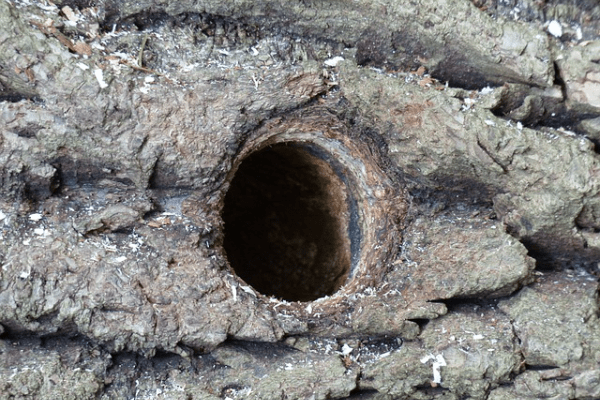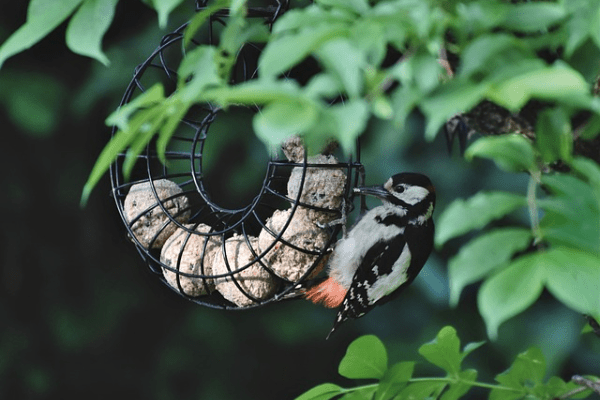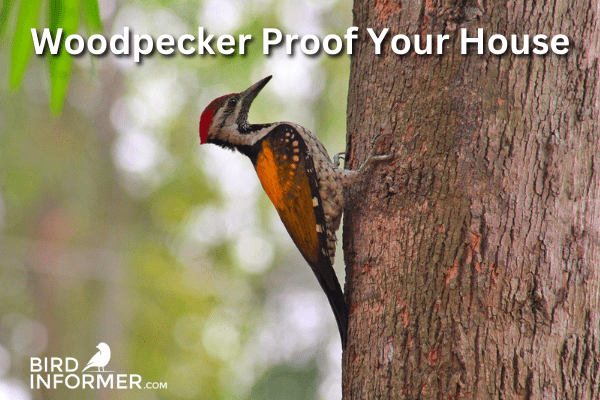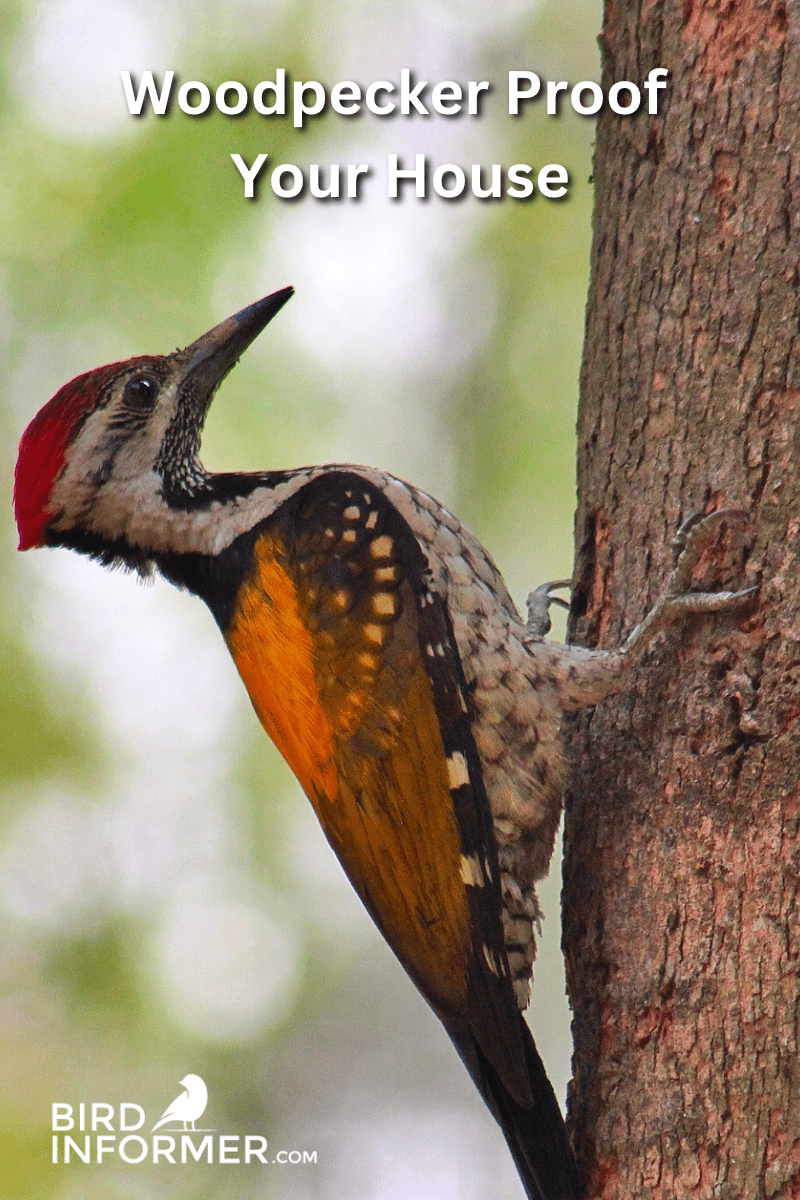Contents
Are you trying to figure out how to make a woodpecker stop hammering on your house once and for all? Not only is it loud and obnoxious, but it’s also very damaging to your home. Keep reading to discover our best tips to get woodpeckers to leave your house alone.
Some successful methods to deter woodpeckers from hammering on your home include removing their favorite food sources and removing large trees near the house. Or put pinwheels, shiny helium balloons, or windsocks near your home. Reflective tape and aluminum foil strips also scare away woodpeckers.
Right now, I’ll take time to expand on each of the best ways to woodpecker-proof your house. I’ll also dive deeply into other important and related topics that will help keep your home woodpecker-proof and free from banging and hammering from these unforgiving birds. The topics I’ll cover in greater detail include:
- Signs of damage caused by pecking woodpeckers
- Reasons why woodpeckers hammer/knock on houses
- Tips to woodpecker proof your house
- Ways to prevent woodpeckers from returning to your home
To learn much more about woodpecker proofing your house and other related topics, please continue reading this valuable information. I’ll answer your most important questions below.
Woodpecker Destruction: Telltale Signs of Woodpecker Damage on Your Home

There are two main reasons why woodpeckers love to perform their knocking/hammering/pecking behavior. The reasons include:
- Finding and retrieving food
- Communicating with other woodpeckers
Believe it or not, woodpeckers love to take their beaks and smash them into wood surfaces in an effort to find food. Most people may not know this, but in many instances, there are insects and bugs that live inside the wood. They become tasty treats and delicious morsels for the woodpeckers to devour.
Drumming their pointy beaks on hard surfaces is also a popular way for woodpeckers to communicate with other birds as well as one another. When they drum their beaks on a hard surface, it often has two purposes that include:
- Engaging in the courtship ritual
- Marking their territory
According to thisoldhouse.com, “Of course, this fascinating behavior also makes them pests. Repeated drumming from a woodpecker’s bill can damage a variety of surfaces. They can drill holes in trees, wooden structures, and even stucco siding.”
Related article: Downy woodpecker
What Does Woodpecker Damage Tend to Look like?
Characteristically speaking, pecking damage caused by woodpeckers tends to appear as a series of small holes. These holes can go very deep into the surface and appear in a vertical or horizontal line.
As an alternative, the woodpecker may hammer away to the point where it creates large nesting holes.
More often than not, the homeowner can typically determine when woodpecker hammering damage is the cause as opposed to damage delivered by unfriendly insects. How so? They’ll hear hammering and loud noises, and see holes regularly appearing inside the siding of their house, which are usually dead giveaways!
Why Do Woodpeckers Love to Drill Holes in Metal Surfaces?
More than likely, you will not find a woodpecker looking for food or taking shelter in a metal gutter or chimney. Yet, these determined birds tend to love banging and hammering away on these surfaces.
Why? By drumming on metal surfaces, they have the ability to produce a sound that’s much louder than they would make when banging on wood or other services.
Why would they want to make a louder sound? In truth, this is important when it comes to claiming territory. The louder the sound they make while drumming, the farther and louder their message will spread, which says that they claim this particular territory, so other birds should stay away.
When it comes to banging on metal surfaces, these woodpeckers likely will not cause massive damage to your home or property. But the incessant banging and noisemaking will definitely give you a huge headache in no time at all.
View Our List Of The Best Woodpecker Bird feeders On The Market Today!
These birds are known for pecking trees with their beaks to communicate and make holes for nesting. Click below to learn more!
4 Reasons Why Woodpeckers Love to Knock and Hammer on Houses
- They hammer loudly and produce loud noises to attract a mate or claim their territory. If woodpeckers are drumming away for these specific reasons, they’ll eventually stop once springtime arrives and breeding season begins. They even avoid drumming while seeking food.
- They drum loudly and hammer away in an effort to excavate a roost hole or nest. If the woodpecker is in the process of digging out a nest cavity, it will hammer away to create a large, round hole. Their nesting holes are typically dug out right at the beginning of the breeding season, which happens during late April and throughout May. It’s best to remove woodpeckers from your home prior to or after their nesting season.
- They drum and hammer incessantly because they’ve discovered that insects are living within the siding of your home. If they are attempting to dig for insects, you’ll find irregular and small holes in the siding of your house. If you have a major insect problem, you’ll likely need to call an exterminator to get rid of the insects, which will also get rid of the unwanted woodpeckers damaging your property. Their favorite aluminum siding-burrowing insects include grass bagworms, leafcutter bees, and carpenter bees.
- They are drilling holes in an effort to store their food. In the western part of the United States, the acorn woodpecker will potentially peck hundreds of different holes the size of an acorn into houses or large trees. Within each hole, they will stash one of their acorns.
Most Effective Woodpecker Deterrent

Just because the woodpecker is a major pest, it doesn’t mean you actually want to kill woodpeckers just because it is annoying you. In fact, these beautiful birds are necessary parts of the overall ecosystem, just like you and me. They’re interesting, beautiful, and amazing birds that we must do everything in our power to protect and keep safe.
Also, woodpeckers are protected in the United States by the Migratory Bird Act of 1918. So, the overall goal of woodpecker proofing isn’t to eliminate these birds. On the contrary, the goal and major focus is to direct them away from your landscape or home.
We’ll look at three important ways to accomplish this task.
Remove or Change Their Available Food Source
Primarily, the main food source of woodpeckers is insects. Do you have an infestation of insects in or around your home? If so, woodpeckers will love your property because it’s like having a smorgasbord or buffet of tasty morsels readily available to eat.
When woodpeckers target homes, they tend to focus on a few common bugs and insect species. They really love termites, ants, and bees and they look for infestations of these insects every chance they get.
Signs of dead insects, rotting wood, and hives are major telltale signs that bugs and insects are infesting your property. If these signs are present – along with unwanted woodpeckers – you have to treat insects, by taking care of them yourself or calling an exterminator. A local pest control company will gladly read your property of unwanted insects and other pests if given the opportunity.
What happens if your home is still being overrun with woodpeckers even though you’ve gotten rid of their favorite food source? Well, the other option is to provide them with a different food source. Give these birds something else to eat and maybe they’ll begin leaving your home and property alone.
Some popular options include:
- Suet Feeders
- Cow Fat Food Sources
- Fruits
- Berries
- Mealworms
- Peanuts
- Nectar
- Sunflower Seeds/Chips
- Cracked Corn
To begin with, keep the birdfeeder close to your house at first and make sure you truly get their attention. Once the woodpecker or woodpeckers begin eating out of the feeder, you should gradually move it further and further away from your home. Move it a couple of feet away each day until the woodpeckers are no longer damaging your property.
On a side note, woodpeckers really love to eat berries and fruits. If you have the time and wherewithal, you could always plant berry bushes and fruit trees in your backyard on the perimeter of your property, but make sure the trees and bushes are far away from your house. This will divert the woodpeckers’ attention and keep them away from your valuable home.
Frighten Away the Woodpeckers
If you have a woodpecker problem at home, you definitely need to consider investing in woodpecker deterrents.
According to allaboutbirds.org, “Homeowners have reported some success deterring woodpeckers with windsocks, pinwheels, helium balloons (shiny, bright Mylar balloons are especially effective), strips of aluminum foil, or reflective tape.” Wind chimes also work to scare woodpeckers away.
In other words, you need to consider placing objects that hang, make sounds, move, or reflect light near the siding of your home. It is especially important to put each woodpecker deterrent near places around your home that woodpeckers tend to gravitate toward.
Some examples of other deterrents include: hanging old CDs that reflect the light, putting up a pinwheel that spins when it’s windy outside, and hanging up wind chimes that make soft but loud noises to scare woodpeckers away.
Unfortunately, using woodpecker deterrents isn’t a perfect solution in every case. In many instances, the homeowners will have success with these methods to deter woodpeckers for a short while, but they will eventually stop working once the woodpeckers become accustomed to them.
Another option is to buy a decoy owl. This is an interesting proposition because it scares the woodpeckers away because owls are natural predators of these birds. The woodpeckers are deathly afraid of owls, and rightfully so, so they will avoid your home when a decoy owl is in place. Once again, it’s unfortunate that decoy owls do not necessarily create a permanent solution.
My personal favorite and the method that most homeowners have success with is using reflective scare tape. This tape has the best track record out of the majority of available woodpecker deterrents that you could attempt to try.
How does it work? You’ll have to pick up reflective scare tape and cut it into long strips. Let the strips dangle down in front of the areas that are most damaged by the woodpeckers hammering away on your property.
As the tape begins to blow around in the breeze, the shiny and very reflective surface will begin to irritate the woodpeckers. The reflective tape tends to irritate their eyes and it will keep the woodpeckers away from your home.
Remember, woodpecker scare tape doesn’t last forever. Over time, it will eventually detach or begin to deteriorate. You’ll need to replace it when necessary.
Keep Woodpeckers Away from Your Home for Good
As you are about to learn, there is a definite permanent solution to your problem but it requires bird netting. This product is the most effective way to keep woodpeckers away as reliably as possible.
How does it work?
You’ll have to hang up bird netting with a 1-inch or smaller mesh, otherwise, the woodpeckers will be able to make their way through. You’ll hang it up 3 inches away from the part of your property being damaged by woodpeckers, so make sure it doesn’t touch the surface but remains very close.
By hanging up this netting, you will prevent the woodpeckers from physically harming your property. You can also use it to protect your trees if the woodpeckers are hammering away your tree trunks.
The only downside is that many people find it time-consuming to correctly install bird netting. On the plus side, it’s a lot less noticeable when compared to reflective tape, so it isn’t going to be a major eyesore on your property.
Lastly, it’s always wise to hire a pest control company to get rid of any insects that might be attracting the woodpeckers to your home. Contact multiple companies and get quotes from each of them, which gives you the ability to find the top pest control provider at the lowest price.


